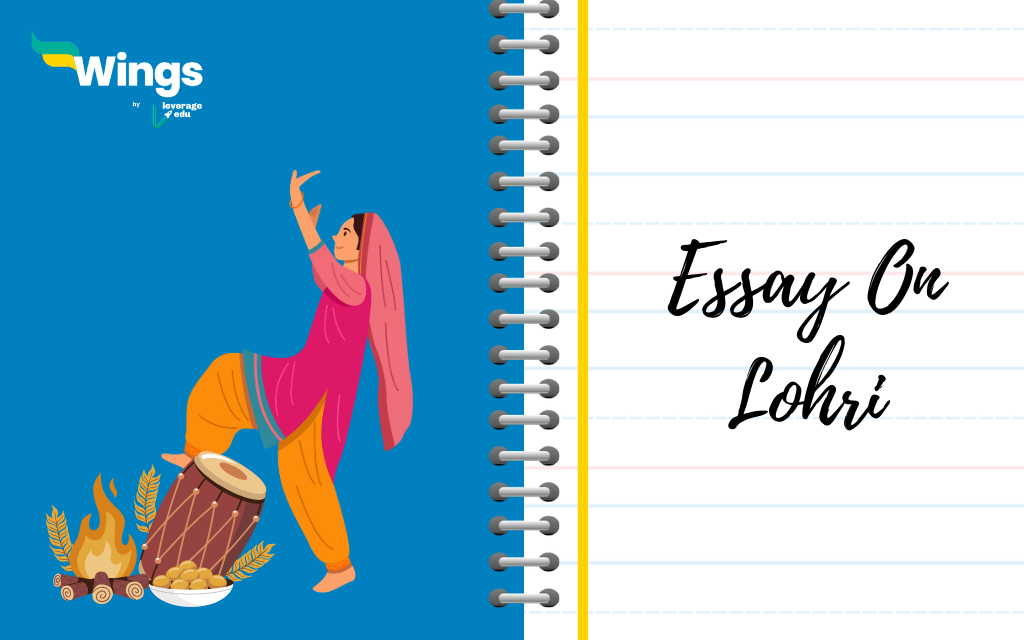Essay on Lohri: India is a land of festivals. From Diwali´s colourful lights to Holi´s vibrant colours, every festival summarises its rich heritage. Rooted in history and spiritual learning, the festivals bring communities together and go beyond regional and religious boundaries.
Among the list of Indian festivals, Lohri is a festival that goes beyond festivals. It not only symbolizes the rich culture of the nation but also highlights the unity in diversity and creates a sense of the warmth of traditions and collective heritage.
Contents
Essay on Lohri in 100 Words in English
Lohri is a popular harvesting festival in Punjab that holds its cultural importance. It is celebrated in the middle of January each year with pomp and show. The festival has its unique importance as it marks the end of winter and the beginning of summer in the north. The people dance around the bonfires sing songs and distribute festive treats like sesame seed sweets and peanuts.
The objective of the festival is to express their gratitude for the sun and its important role in agriculture. In other words, the festival holds significance for a new beginning of Rabi crops and wishes for the fruitful harvesting of crops throughout the year.
Also Read: Happy Baisakhi 2023
Also Read: Regional Festivals in India
Essay on Lohri in 200 Words in English
Lohri, which is also known as the harvesting festival, is celebrated in the middle of January every year. The festival holds historical and cultural significance in India, particularly in Punjab, Haryana, and Himachal Pradesh. As a harvesting festival, Lohri marks the shift from winter to spring, signifying longer days and shorter nights.
It is a festival celebrated that includes bonfires, dancing to the beats of dhol, and lots of traditional dishes and folk songs. Men and women enjoy the festival by participating in bhangra. Children go door to door and receive and sing folk songs. In return, they receive offerings with the blessing of the elders.
Lohri revolves around the worship of the sun and fire. The festival emphasises the reunion of families, love exchanges, and the strengthening of bonds among them. In Punjab, Lohri holds special importance by uniting people across religious lines to celebrate the festival of harvesting.
The celebration of the festival is enhanced by narrating the legendary tale of Dulla Bhatti, who is also referred to as the Robin Hood of Punjab because of his acts of bravery, generosity, and standing up against injustice.
Lohri, the festival of harvesting and bonfires, is not just a festival; it is a culture that shows unity and joy through the sharing of religious and cultural differences. With historical roots, vibrant celebrations, and diverse participation, Lohri stands as a symbol of communal harmony in India´s rich festival land.
Essay on Lohri in 300 Words in English
Lohri is a festival that brings joy and celebration to the farmers of India. It is a special festival that holds a special place in the hearts of the people of India. It is primarily celebrated in the northern states of Punjab, Haryana, and Himachal Pradesh. The festival celebrates waiving goodbye to the winter season and welcoming the longer days of summer. Lohri is a cultural festival that is incomplete without the lighting of bonfires, traditional music, and lots of festive foods.
Lohri is celebrated in Punjab with agrarian traditions, which means a major portion of the income for the farmers of Punjab comes from agriculture. To return this with gratitude, the farmers gather around the bonfires, sing traditional songs, and perform the energetic bhangra.
Every festival has a story behind it; similarly, Lohri too celebrates the story of Dulla Bhatti behind it. Dulla Bhatti, also known as the Robinhood of Punjab, was the real hero of the local people. During the reign of the Mughals, he helped rescue some unmarried girls. Because of his brave act and helping people, he marks parts of the Lohri festival as an act of bravery. People celebrate and sing songs for the brave acts of Dulla Batti and praise him in their celebration.
In conclusion, Lohri, the festival of happiness and celebration, symbolises the richness and diversity of India. With variation in celebrations, each state adds uniqueness to the celebration. To add more colour to the festival, school students are encouraged to involve themselves in celebrations not only in traditional ways but also using social media posts. Also, the families share the warmth of Christmas with friends and family across the world using video calls. With this advancement, Lohri successfully continues to connect generations and welcomes the changes as well.
FAQs
Lohri, which is also known as the harvesting festival, is celebrated in the middle of January every year. The festival holds historical and cultural significance in India, particularly in Punjab, Haryana, and Himachal Pradesh. As a harvesting festival, Lohri marks the shift from winter to spring, signifying longer days and shorter nights.
The festival is associated with the reverence of Dulha Bhati, who was a legendary hero who helped the poor during the reign of the Mughal Emperor.
The message of Lohri revolves around the celebration of the harvesting season, an abundance of crops and the blessing of prosperity.
Lohri does not belong to a specific religion. It is a festival primarily that is celebrated particularly in the northern region of India.
The name Lohri is derived from the word ¨Loi,¨ which means the end of the winter season. Another story suggests that the name of Lohri comes from the word ¨Loh¨ which means, a thick iron griddle or tava used for making chapatis.
Related Articles
 One app for all your study abroad needs
One app for all your study abroad needs














